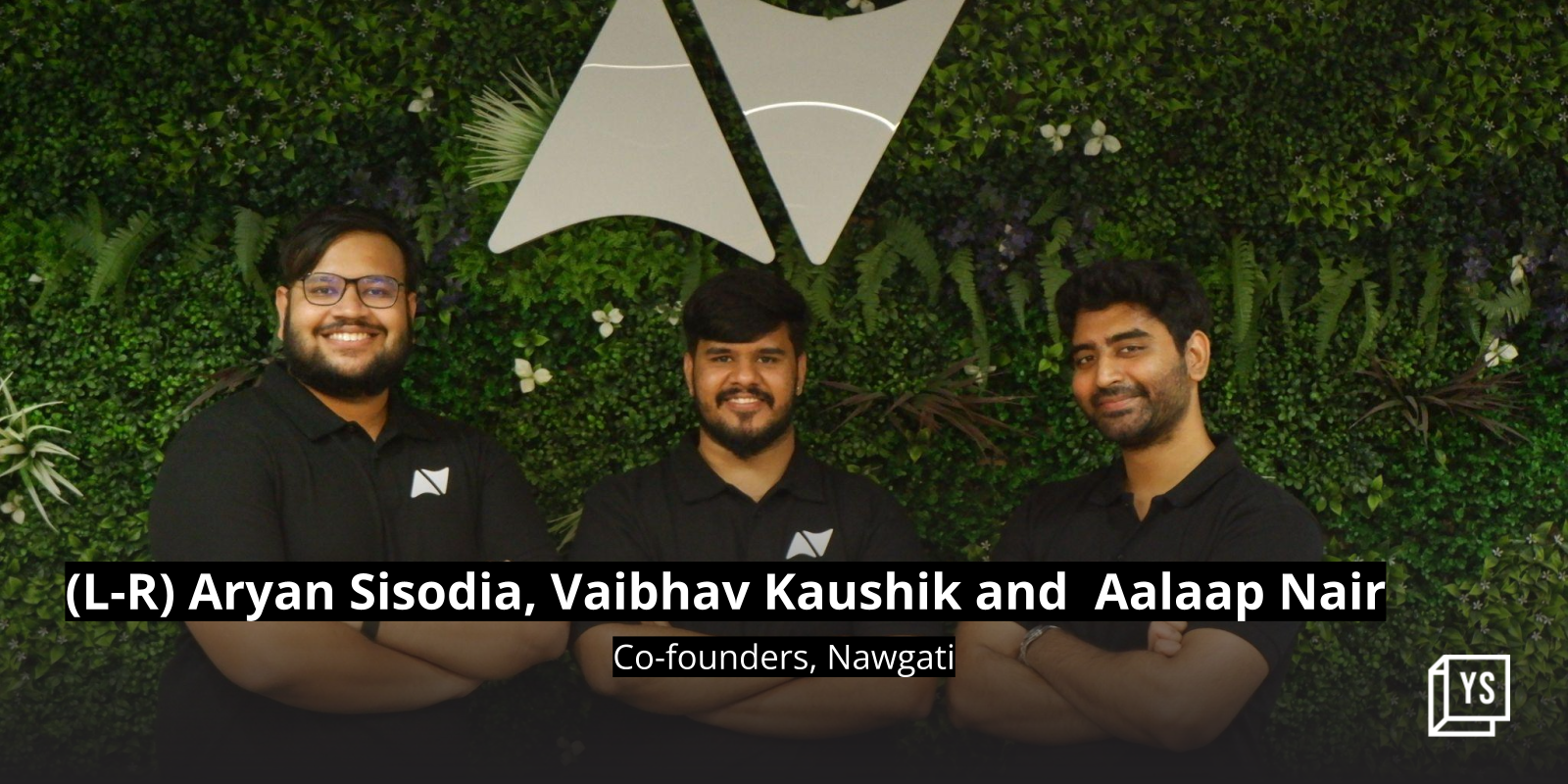
Four years ago, Vaibhav Kaushik, a resident of Greater Noida, often took or rides from home to his workplace where he was doing an internship. Whenever he passed by fuel stations, CNG outlets in particular, he often saw winding queues, with people waiting for a long time for their turn to fuel up.
When Kaushik struck up a conversation with a taxi driver, he learnt that the wait at CNG stations usually cost him 10% of his daily income.
“It bothered me how much time and money people were wasting in these queues and how much they could save if only they knew about other fuel stations nearby with less crowd,” says Kaushik.
This prompted him to find a solution for the same. He teamed up with his friends Aalaap Nair and Aryan Sisodia, while still in college, and founded Nawgati–a fuel-agnostic queue management platform.
The startup offers a one-stop fuel aggregator platform designed to address the challenges of congestion and compliance monitoring at fuel stations dealing with CNG, petrol, and diesel. It utilises deep learning technology to provide real-time updates on congestion at fuel stations, thus helping fuel stations and consumers plan ahead, make informed decisions, and ultimately save time and money.
Nawgati’s in-house deep learning algorithms use the feed from existing infrastructure installed at the stations to segment vehicles into different vehicle categories (cars, autos, heavy vehicles, etc), identify repeat trips at an outlet, and monitor SOPs and utilisation of assets.
A pilot project was conducted with a fuel outlet of Indraprastha Gas Ltd in Delhi in 2021.
The word ‘nawgati’ is derived from the Sanskrit word ‘navgatih’, which means ‘navigation’, and reflects the company’s mission to help fuel providers and consumers navigate the process of fuelling.
“We aim to enhance the fuelling experience by streamlining operations at fuel stations and improving awareness about nearby station statuses, thus saving time for fuel providers and consumers and reducing congestion,” says Kaushik.
Services on offer
Nawgati offers two services–Aaveg, a data-backed B2B platform, and Nawgati Fuelling App, catering to consumers.
The B2C fuel discovery app provides information on fuel rate, availability, and wait/serve time, thus enabling users to make informed choices. It also allows users to review and rate their experiences at the fuel station.
Aaveg is a vertical SaaS offering that provides a comprehensive overview of each fuel station on a dashboard with real-time information on transit time, waiting time, serving time, attendants deployed, and information on under/over-utilisation of resources, thus enabling fuel outlets to make decisions to reduce congestion and improve service.
“Aaveg connects to existing infrastructure and native devices installed at stations, enabling real-time tracking of movement with minimal to zero time lapse. Our deep learning technology traces and detects each vehicle,” explains Kaushik.
An edge controller device deployed at the outlet connects to the pre-existing infrastructure, processes real-time data, and sends the results to the cloud for insights into congestion, forecourt (area where attendants are present) operations, and compliance with safety standards and emission norms.
Through the Aaveg dashboard, fuel providers can monitor the assets and metrics of their stations and gain insights into their operations, customer satisfaction and repeat visits, and compliance management.
The platform offers reports summarising core business metrics in seconds and allows users to take action on the go and set up notification pipelines and workflows.
To protect sensitive information from unauthorised access and cyber threats, the platform employs data encryption technologies for secure transmission between the hardware and the cloud. It also uses a role-based access control feature to restrict third-party access to the data and enhance resilience to cyber attacks.
“Earlier, the fuel stations used to manually record the day-to-day data such as compliance details, transactions, attendance. However, with Aaveg, they can automate the process and manage all activities via state-of-the-art technology,” says Kaushik.
“Automating operations allows fuel stations to enhance efficiency and reduce overhead costs, miscellaneous expenses, and pilferage at their outlets, ultimately improving customer satisfaction and reducing overall expenses,” he adds.
Business model
For a monthly fee, petrol stations or companies can deploy the B2B Aaveg service at as many stations as they require. Subscription charges start at Rs 5,000 per station per month.
Basic features on the B2C Nawgati fuelling app are free for all users, but certain paid premium features are in the pipeline.
Another revenue stream–a congestion data API, aimed at fleet operators–will be launched by the end of the year, reducing overall vehicle downtime.
.thumbnailWrapper
width:6.62rem !important;
.alsoReadTitleImage
min-width: 81px !important;
min-height: 81px !important;
.alsoReadMainTitleText
font-size: 14px !important;
line-height: 20px !important;
.alsoReadHeadText
font-size: 24px !important;
line-height: 20px !important;

The startup has installed its edge controller at more than 150 fuel stations of Indraprastha Gas Ltd and Indian Oil Corporation in Delhi-NCR and at Mahanagar Gas Ltd outlets in Mumbai. Devices are also deployed at the outlets of HPCL, Sabarmati Gas, Gujarat Gas, Torrent Gas and petrol pump dealers across India.
The startup is in discussions with Adani Gas, Think Gas, Green Gas, Vadodara Gas, Rajasthan State Gas, AG&P, Maharashtra Natural Gas, and other fuel companies.
The startup is in the process of onboarding 2,000 more fuel stations on Aaveg. It also plans to expand its reach in Tier I and II cities, including Delhi NCR, Mumbai, Ahmedabad, Bengaluru, Kolkata, Bhopal, Chennai, Pune, Lucknow, Patna, and Jaipur, over the next six months.
So far, the startup has onboarded more than 10 lakh users on its B2C fuel discovery app, including a select group of Nawgati Super Users who have played a crucial role in testing new features.
“We have captured a small group of super users and created a WhatApp group with them. This group has acted as a beta tester group, and they have been helping us test new features and improve the quality of the experience,” elaborates Kaushik.
The startup hopes to reach an annual recurring revenue (ARR) of $1.5 million in the next few quarters and an ARR of over Rs 200 crore by 2027.
Market play and growth
India ranks third in the world in terms of oil and gas consumption after China and the United States of America.
With more than 86,500 oil and gas stations, the sector exhibits promising growth, at a projected CAGR of 10-12% from 2023-2026, according to BP Statistical Review of World Energy 2022.
Nawgati received initial support from PIED Society and was funded by the Ministry of Electronics and IT’s TIDE 2.0 scheme in 2020. It also obtained funding from the MeitY StartUp Hub TIDE 2.0 scheme, Department of Science and Technology, , Shark Tank investors, and angel investors.
The startup was part of TechSparks 2023, YourStory’s flagship tech startup event held recently in Bengaluru, and made it to YourStory’s Tech30 list, as one of the 30 most promising Indian startups of 2023.
“The Tech30 platform provided a unique opportunity to connect with a group of innovative minds, boosting morale and ensuring seamless customer solutions. Sharing our journey and gaining valuable insights from fellow entrepreneurs helped the company expand and improve its future growth,” says Kaushik.
Recently, Nawgati secured an undisclosed amount as seed funding in a round led by All in Capital for geographical expansion and onboarding fuel pump stations over the next six months.
The startup plans to expand its fuel-agnostic platform to include electric vehicle charging stations. It aims to onboard 15,000 fuel outlets over two years and have 20 million users on its B2C fuelling app in two to three years.
Edited by Swetha Kannan










